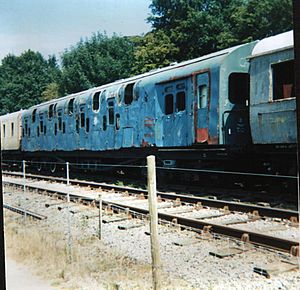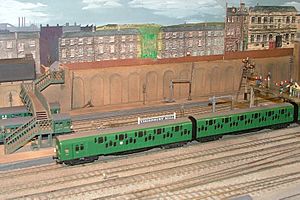SR Class 4DD facts for kids
The 4DD was a special type of electric multiple unit train. It was the only double-deck train ever to run on the main railway lines in Britain. These trains were designed by Oliver Bulleid for the Southern Railway. They were meant to carry many passengers on busy routes, like the one to Dartford.
Contents
What Was the 4DD Train?
The 4DD trains were unique because they had two levels of seats, one above the other. This was done to fit more people into each train car. The designers had to be very clever to make sure the train was not too tall. It needed to fit through tunnels and under bridges safely.
How Did the Double-Deck Design Work?
To make space for the upper level, the seats there were tucked in between the lower-level seats. This helped keep the train's total height low. However, this design led to some problems. The upper compartments felt a bit cramped. Also, the windows on the upper level could not be opened. This was because there was not enough space for them to slide open.
Challenges Faced by the 4DD
The 4DD trains had a special system to push fresh air into the compartments. This was called "pressure-ventilation." But this system often broke down. This made the upper areas uncomfortable for passengers.
Another problem was how long the train stopped at stations. Because there were more seats, more people got on and off at each door. This meant the train stayed at the station for a longer time. These longer stops are called "dwell times."
Why the 4DD Was Not a Success
Because of the cramped upper level, ventilation problems, and longer stops, the 4DD trains were not very successful. The railway wanted to carry more passengers. Instead of building more double-deck trains, they found a simpler solution. They decided to make their regular trains longer. They added more cars to trains, changing them from eight cars to ten. This gave them the extra seating capacity they needed without the issues of the double-deck design.



